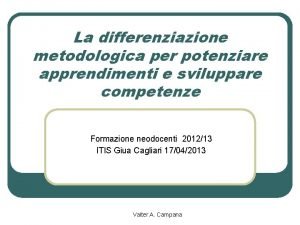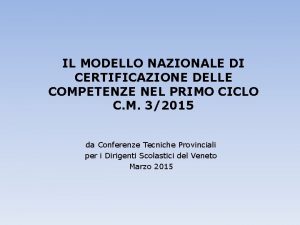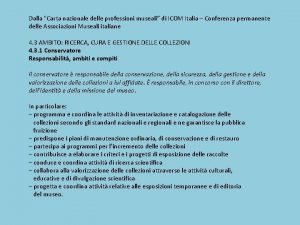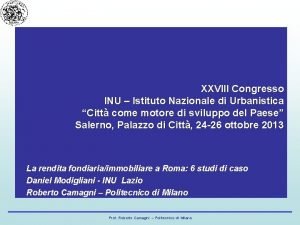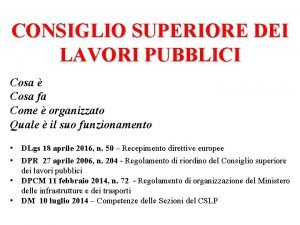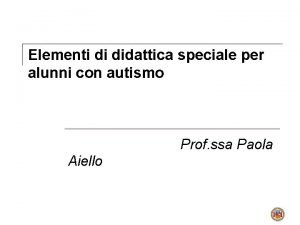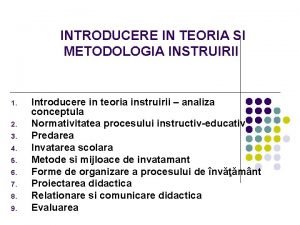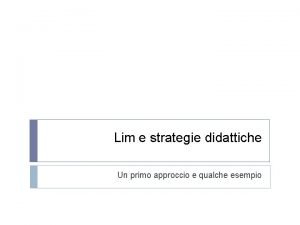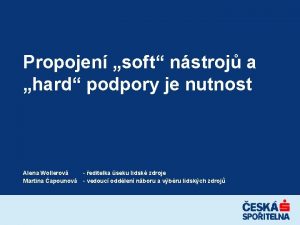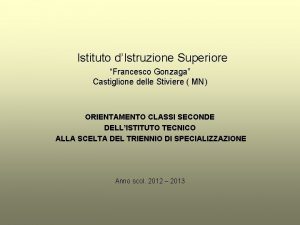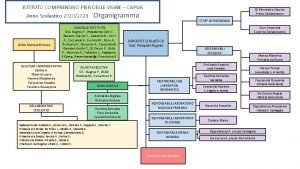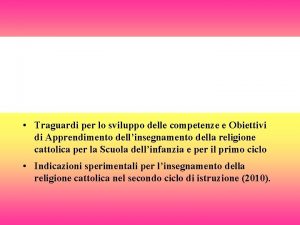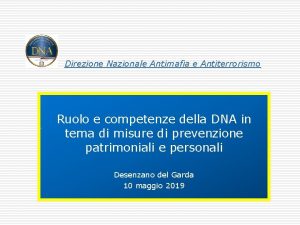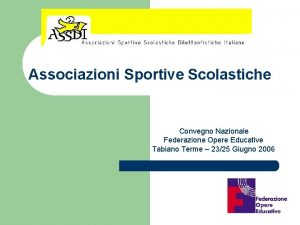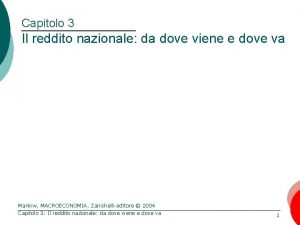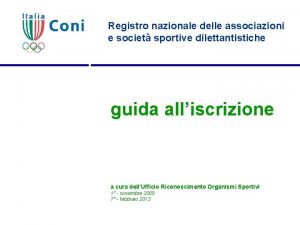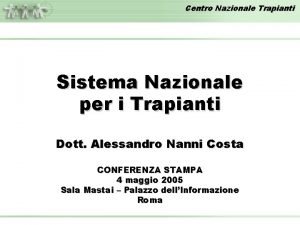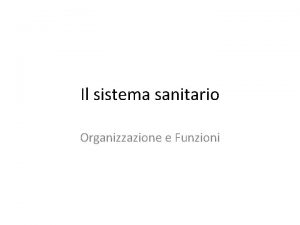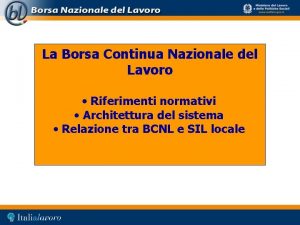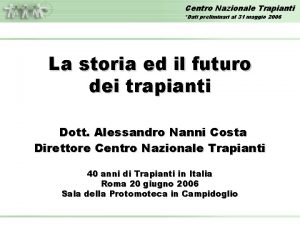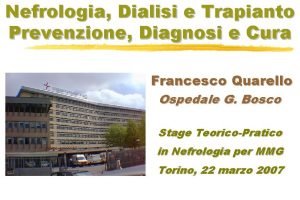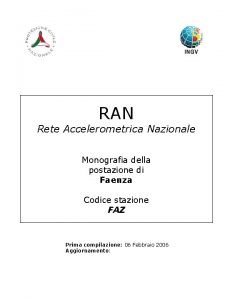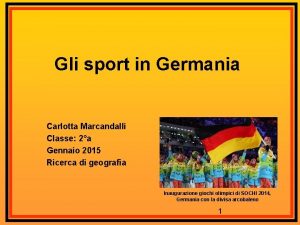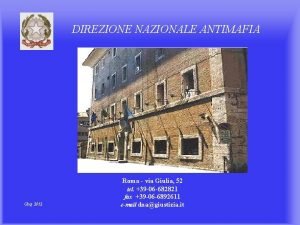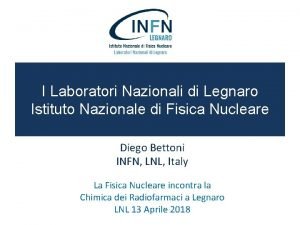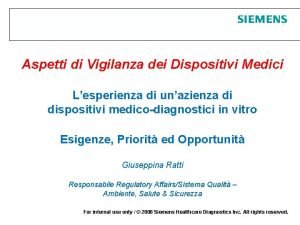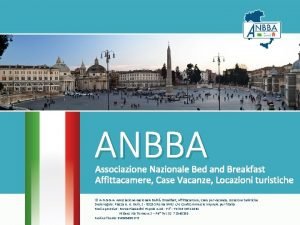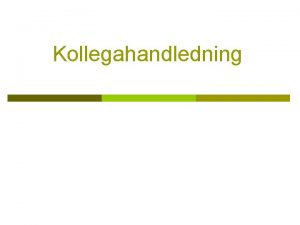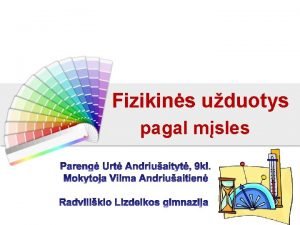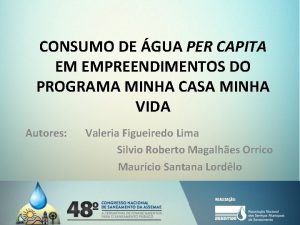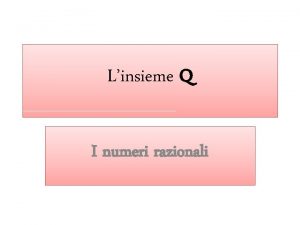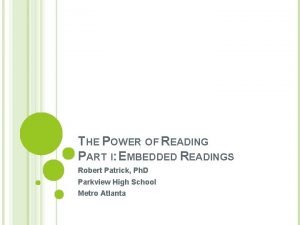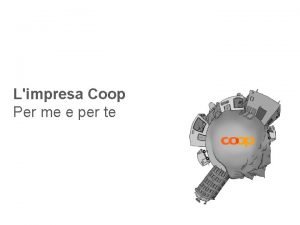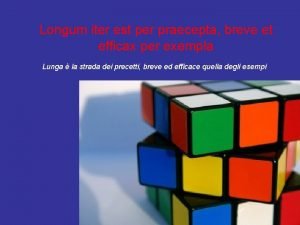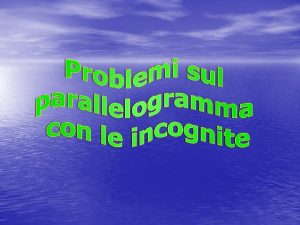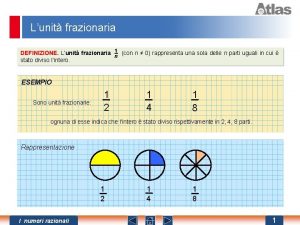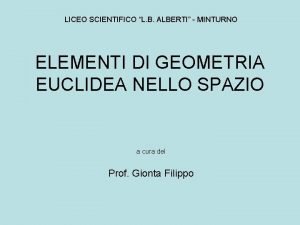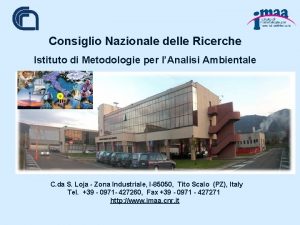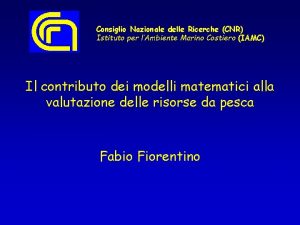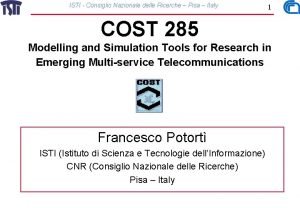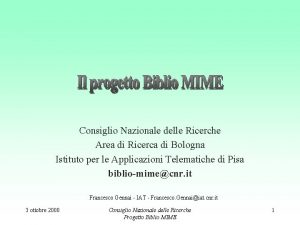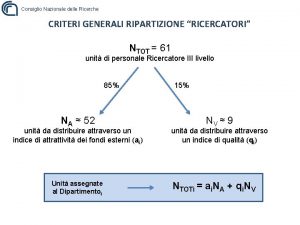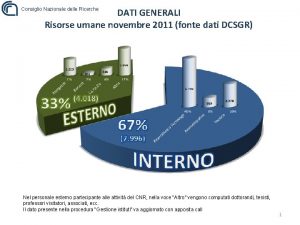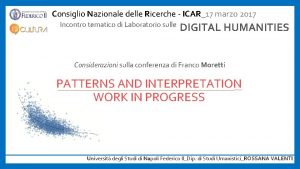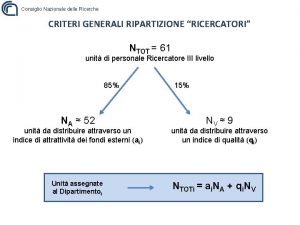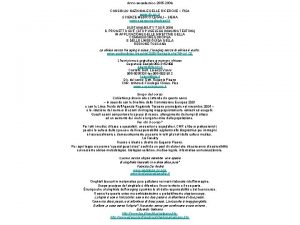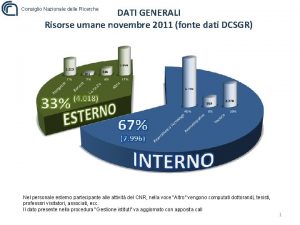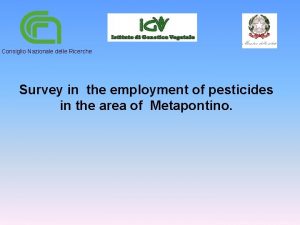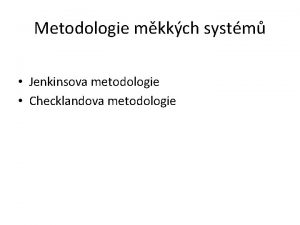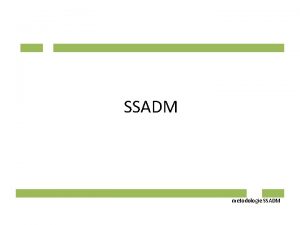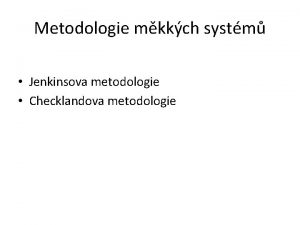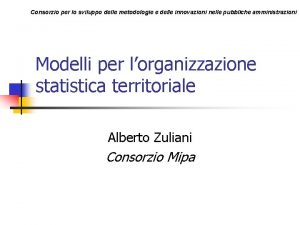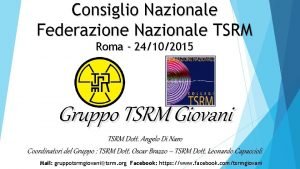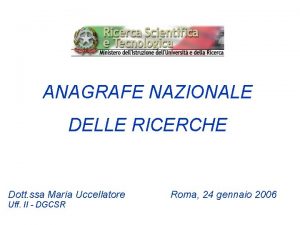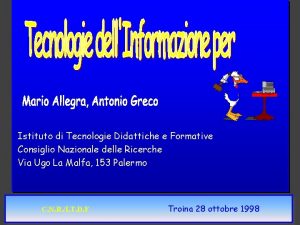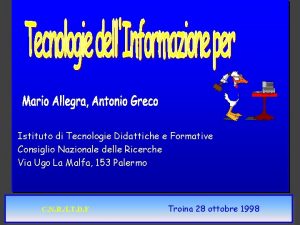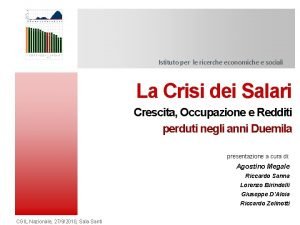Consiglio Nazionale delle Ricerche Istituto di Metodologie per































































- Slides: 63

Consiglio Nazionale delle Ricerche Istituto di Metodologie per l’Analisi Ambientale Neural Network Approach to the Inversion of High Spectral Resolution Observations for Temperature, Water Vapor and Ozone ØDIFA-University of Basilicata (C. Serio and A. Carissimo) ØIMAA-CNR (G. Masiello, M. Viggiano, V. Cuomo) ØIAC-CNR (I. De. Feis) ØDET-University of Florence (A. Luchetta) Thanks to EUMETSAT (P. Schlüssel)

Outline • Neural Network Methodology • Neural Net vs. EOF Regression (IASI Retrieval exercise) • Physical inversion methodology • Physical inversion vs. EOF Regression (a few retrieval examples from IMG)

Introductory Remarks The Physical forward/inverse scheme for IASI • -IASI is a software package intended for • • Generation of IASI synthetic spectra Inversion for geophysical parameters: 1. 2. 3. temperature profile, water vapour profile, low vertical resolution profiles of O 3, CO, CH 4, N 2 O.

Introductory Remarks The -IASI family • -IASI: forward model (available in Fortran with user’s guide) • -IASI: physical inverse scheme (available in Fortran with user’s guide) • 2 -IASI: neural network inversion scheme (available in C++ with user’s guide) • -IASI: EOF based regression scheme (available in MATLAB, user’s guide in progress).

Neural Net Methodology Theoretical basis of Neural Network K. Hornik, M. Stinchcombe, and H. White, Multilayer feedforward networks are universal approximators Neural Networks, 2, 359 -366, 1989

Basic Mathematical Structure of a generic i-th Neuron x 1 wi 2 x 2 • • • x. N • wi 1 (witx) oi

Cost Function to determine the weights

Multilayer feed-forward Architecture

Simultaneous Architecture for (T, H 2 O, O 3) retrieval

Inter-comparison exercise: NN vs. EOF regression • NEURAL NET • EOF regression • Input projected into an EOF basis: 50 PCs EOF basis: 200 PCs retained (Optimized) • Output projected into EOF basis: 15 PC for T, 10 for H 2 O, 15 for O 3

Rule of the comparison • Compare the two schemes on a common basis: – same a-priori information (training data-set), – same inversion strategy: simultaneous – same quality of the observations

Definition of the spectral ranges

Training/Validation and Test Data Sets 2311 TIGR profiles (TIGR-3 data base) RIE Test Data Set, EUMETSAT

Tropical Air Mass (RIE test data set)

Tropical Air Mass

Tropical Air Mass

Summary • NN performs better than EOF Regression provided that they are evaluated on a common basis. • NN is parsimonious with respect to EOF regression (50 PCs vs. 200 PCs)

Optimization Eof Regression Localize training (Tropics, Mid-Latitude, and so on)

Tropical Air Mass

Tropical Air Mass

Tropical Air Mass

Summary • EOF regression improves when properly localized • Neural Net is expected to improve, as well. Results are not yet ready.

Dependency on the Training data set • One major concerns with both the schemes is their critical dependence on the training data set

Comparing N. N. to EOF Reg. IMG Mid-Latitude Observation

Comparing N. N. to EOF Reg. IMG Tropical Observation

How to get rid of data-set dependency?

Physical Retrieval (Initialized by Climatology) EOF Regression Circles: ecmwf; Line: retrieval Introducing Physical Inversion

Physical Retrieval EOF Regression (Initialized by Climatology) Introducing Physical Inversion

Statistical Regularization Tikhonov/Twomey Regularization Data constrained Optimisation

The subscript g stands for a suitable background atmospheric state! Our Approach to Physical Inversion

About L • Twomey’s approach • Rodgers’ approach • L is intrinsically a covariance operator, B in his notation • n=0, 1, 2

Physical Consistency of the L-norm Twomey’s L is lacking dimensional consistency! it attempts to Sum unlike quantity, e, g, (K+g/kg) Rodgers’ L ensures dimensional consistency L=B-1 which makes the norm above dimensionless

Our Choice • Since we are interested in simultaneous inversion which involves unlike quantities such as Temperature, water vapour concentration and so on we choose • L=B-1 • However, the methodology we are going to discuss still hold for any Twomey’s L

Finding the solution through Lagrange multiplier method

Uncovering the elemental constituent of regularization Ridge Regression

Continued • The same decomposition may obtained for Twomey regularization by putting • L=Mt. M • M may be obtained by Cholesky decomposition for any symmetric full rank matrix L • Twomey’s L is typically singular. Nevertheless the above decomposition may be obtained by resorting to GSVD (Hansen, SIAM Review, Vol. 34, pp. 561, (1992))

Summary • The RIDGE regression is the paradigm of any regularization method, • The difference between the various methods is: Øthe way they normalize the Jacobian Øthe value they assign to the Lagrange multiplier

Ø Ø • Levenberg-Marquardt: is assigned alternatively a small or a large value, the Jacobian is not normalized, that is L=I. • Thikonov is a free-parameter (chosen by trial and error), the Jacobian is normalized through a mathematical operator. • Rodgers: =1, the Jacobian is normalized to the a-priori covariance matrix. It is the method which enables dimensional consistency. § Our Approach Rodgers approach combined with an optimal choice of the parameter (Lcurve criterion).

A simple numerical exercise

Statistical Regularization 1 st Iteration

Statistical Regularization 2 nd Iteration

L-Curve, 1 st Iteration

L-Curve, 2 nd Iteration

Convergence example based on an IMG real spectrum • Inversion strategy: – 667 to 830 cm-1 simultaneous for (T, H 2 O) – 1100 to 1600 cm-1 (super channels) sequential for H 2 O alone – 1000 to 1080 cm-1 sequential for Ozone

Temperature

Water Vapor

Ozone

2 -constraint

Physical Inversion vs. EOF regression: Exercise based on Real Observations (IMG) • EOF regression: • Training data set: a set of profiles from ECMWF analyses

Physical Inversion Based on Climatology EOF Regression Circles: ECMWF Analysis









Exercise for tomorrow • Inter-compare – Physical Inversion – EOF Regression – Neural Net • With NAST-I data (work supported by EUMETSAT) • With our AERI-like BOMEM FTS (work supported by Italian Ministry for the research)

Research program to speed up physical inversion (next future)

Develop the RTE in EOF-basis

EOF decomposition of the linearized RTE

Conclusions • • • The inversion tools developed within the ISSWG activities by the DIFA-IMAA-IAC groups have been presented A comparison have been provided of the relative performance of the various methods (although more work is needed) A tentative list for now see at the top the 1. Physical inversion (not suitable for operational end-uses) 2. Neural Network (very fast, still complex to train, its dependence on the training data set has to be assessed) 3. EOF Regression (appealing for its simplicity, the training needs to be localized, does not seem to provide reliable results for H 2 O)
 Classificazione delle metodologie didattiche
Classificazione delle metodologie didattiche Classificazione delle metodologie didattiche
Classificazione delle metodologie didattiche Metodologie didattiche per ritardo mentale
Metodologie didattiche per ritardo mentale Galleria nazionale delle marche
Galleria nazionale delle marche Modello nazionale di certificazione delle competenze
Modello nazionale di certificazione delle competenze Carta nazionale delle professioni museali
Carta nazionale delle professioni museali Istituto nazionale di urbanistica
Istituto nazionale di urbanistica Istituto gemmologico nazionale
Istituto gemmologico nazionale Pelide significato
Pelide significato Rinnovo pec lextel
Rinnovo pec lextel Ezequiel consiglio
Ezequiel consiglio Consiglio superiore dei lavori pubblici
Consiglio superiore dei lavori pubblici Autismo metodologie e strategie didattiche
Autismo metodologie e strategie didattiche Teoria si metodologia instruirii
Teoria si metodologia instruirii Tabella kwl
Tabella kwl Hay metodologie
Hay metodologie La nascita delle lingue e delle letterature romanze
La nascita delle lingue e delle letterature romanze L'esperienza delle cose moderne e la lezione delle antique
L'esperienza delle cose moderne e la lezione delle antique L'esperienza delle cose moderne e la lezione delle antique
L'esperienza delle cose moderne e la lezione delle antique Liceo gonzaga castiglione
Liceo gonzaga castiglione I.c. pier delle vigne capua
I.c. pier delle vigne capua Traguardi per lo sviluppo delle competenze irc
Traguardi per lo sviluppo delle competenze irc Direzione nazionale antimafia e antiterrorismo
Direzione nazionale antimafia e antiterrorismo Assdi nazionale
Assdi nazionale Festa nazionale inghilterra
Festa nazionale inghilterra Fondi mutuabili
Fondi mutuabili Tesori da scoprire fidapa
Tesori da scoprire fidapa Registro nazionale società sportive dilettantistiche
Registro nazionale società sportive dilettantistiche Centro nazionale trapianti
Centro nazionale trapianti Pnsd schema
Pnsd schema Rete accelerometrica nazionale
Rete accelerometrica nazionale Classificazione nazionale dei dispositivi medici
Classificazione nazionale dei dispositivi medici Organigramma sistema sanitario nazionale
Organigramma sistema sanitario nazionale Enac ente nazionale canossiano
Enac ente nazionale canossiano Inno nazionale
Inno nazionale Borsa continua del lavoro
Borsa continua del lavoro Centro nazionale trapianti
Centro nazionale trapianti Centro nazionale trapianti
Centro nazionale trapianti Rete accelerometrica nazionale
Rete accelerometrica nazionale Sport in germania
Sport in germania Direzione nazionale antimafia organigramma
Direzione nazionale antimafia organigramma Base inno di mameli
Base inno di mameli Consolidato nazionale e mondiale differenza
Consolidato nazionale e mondiale differenza Rilab data sc
Rilab data sc Classificazione nazionale dei dispositivi medici
Classificazione nazionale dei dispositivi medici Associazione nazionale bed and breakfast
Associazione nazionale bed and breakfast Itt livia bottardi
Itt livia bottardi I primi tentativi di educazione dei ciechi risalgono
I primi tentativi di educazione dei ciechi risalgono Per capita vs per stirpes
Per capita vs per stirpes Didelis kamuolys auksinių adatų prikištas
Didelis kamuolys auksinių adatų prikištas Per stirpes v per capita
Per stirpes v per capita Approssimazione per difetto e per eccesso
Approssimazione per difetto e per eccesso Catullus 84 translation
Catullus 84 translation 186 282 miles per second into meters per second
186 282 miles per second into meters per second Multas per gentes et multa per aequora vectus
Multas per gentes et multa per aequora vectus Coop per me e per te
Coop per me e per te Is 60 seconds one minute
Is 60 seconds one minute Longum iter est
Longum iter est Il mio diletto canto
Il mio diletto canto 24 km berapa dam
24 km berapa dam Quante altezze ha un triangolo
Quante altezze ha un triangolo Soluzioni il racconto delle scienze naturali
Soluzioni il racconto delle scienze naturali Quando una frazione si dice riducibile
Quando una frazione si dice riducibile Alberti minturno
Alberti minturno

